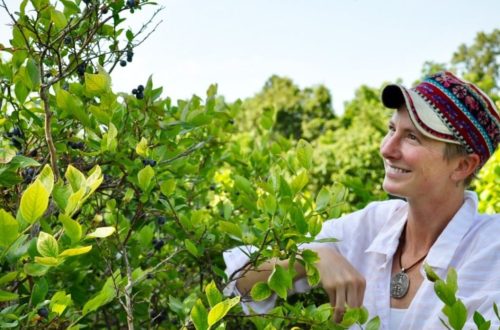
Introducing Air Potatoes
I am always on the hunt for cool perennials to add to our food forests. Eric Toensmeier’s book Perennial Vegetables has been a great resource. We have introduced skirret (Sium sisarum), “air potato” (discussed in this article), improved Apios americana, among other things as a result of leafing through its pages. The air potato especially always caught my eye.

A few years ago I purchased a root start of Dioscorea batatas (often called D. polystachya). I was intrigued that the description on Oikos’ website called this “Chinese Mountain Yam” and mentioned that it was a very popular, tasty, nutritious & prolific staple crop in Asia! I wondered, how could something so amazing (and hardy as it survives frost and many different climactic conditions) be relatively unknown here in North America? I find such perennial root crops (like Skirret and Apios americana mentioned above) especially intriguing. I decided I would experiment with growing Dioscorea batatas. Along with the yam root, the vine also produces aerial tubers known as bulbils which are edible (pictured above). Two edible parts of one plant and one doesn’t even need to be dug?! Very cool!
This led me to also search for another Dioscorea, one that is even more difficult to find. Dioscorea bulbifera. Again, very popular in many parts of Asia (and this one is also popular in Africa), this yam has a (small) root, but boasts golf ball sized bulbils! After much research, I purchased an “African” variety, unique with its angular edges. Both polystachya and bulbifera have naturalized in varying parts of the United States. It seems that once feral, the plant reverts back to containing more of its bitter compounds, presumably as a defense mechanism. Don’t ask anyone from Florida to speak highly of either of these plants!
However, even given their escapee nature, I still believe that these plants are worth growing with care. What goes rampant in the wild can become a prolific & easy food staple when tended intentionally.

How did they do?
Dioscorea batatas
In their 3rd year, the Chinese Mountain Yam vines haven’t spread that much. That’s because each fall I collect the bulbils for food and for sale. You can purchase some on our website or on ebay. I assume that if I didn’t, they would root and grow. We also ate a root one year. At least a foot and a half deep in the earth, we weren’t sure when we would find it! The starchy white root was very delicious in that evening’s soup! The depth of the yam makes me think the harvest would be easier in a raised bed.
Just the other day we ate some aerial bulbils sautéed in butter and wow were they good! I am inspired to plant more of these to create more bulbils for an easy no-dig potato-like addition to meals. If you start the yam from a bulbil and not from a yam root cutting, they take a couple years to really get going.
Dioscorea bulbifera
In spring after my angular bulbifera arrived, I protected it from frost (as an aside, batatas are hardy against frost). It had a couple nodes of growth on the bulbil when I got it. Within a couple weeks after planting in the high tunnel (unheated) after threat of frost, the first vine tips had poked through the soil and were searching for something to climb on. Within a month and a half, they had a great amount of growth, but still no air potatoes! We had a couple months without water due to some well pump issues and the high tunnel experienced a hard drought. The air potato showed no signs of wilt, but it didn’t thrive!

One day I spied the first bulbil forming (pictured above at the end of the season) and I was so happy! Still, nothing, after that. We got our water working again (we had watered with 5 gal buckets brought up from the creek in the interim!) and slowly started watering the high tunnel again as to not overwhelm everything going from 0 to 60. Soon after the plant started receiving water, more bulbils started forming. Now there are probably 10 bulbils of varying sizes with one very large one that was the first to show. Next year I’ll be sure to keep it on a regular watering schedule because it will certainly do much better!

Yams become a staple crop?
Given our shifting climate, increased drought and flooding events and general instability, I think it is wise to start allying with a myriad of crops- especially those that are notably vigorous. I love potatoes and sweet potatoes a lot, and they do really well for us here, AND diversity is key in creating resilient systems. After a few seasons growing D. batatas and one growing D. bulbifera, I feel encouraged to continue experimenting with these plants. The batatas especially, given its cold hardy nature, would do well in and amongst shrubs and trees. In this instance, it has even taken a liking to one of our common food forest nitrogen fixing / chop and drop shrubs, Amorpha fruticosa.
Really excited to be allying with these plants that are so vigorous & already beloved in other areas.





